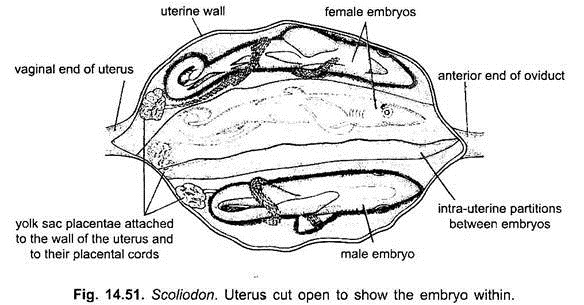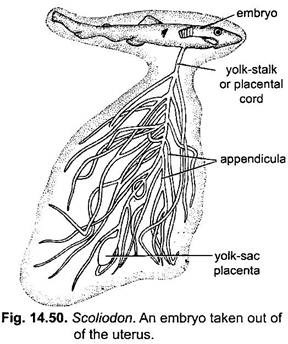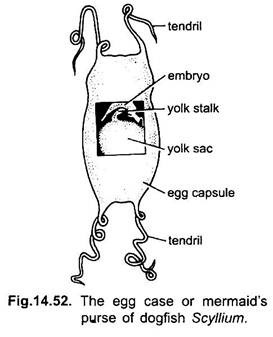In this article we will discuss about the process of reproduction in dogfish with the help of suitable diagrams.
Copulation:
During copulation one or both the claspers of the male are inserted into the cloaca of the female and are fixed in position by the erection of terminal pieces. The spermatic fluid is forced through the grooves of the claspers into the oviducts through the vagina.
Fertilisation:
In Scoliodon, the fertilisation is internal. Fertilisation of mature eggs takes place in the section of the oviduct between the oviducal funnel and the shell-gland.
Development:
The Scoliodon is ovoviviparous. Development of eggs occurs in the uteri and gives birth to living youngs. During the breeding season the two uteri, occupying the greater part of the abdominal cavity, may contain many embryos, i.e., 3 to 7 in each uterus. Each embryo may attain a total length of about 75 cm before birth.
ADVERTISEMENTS:
The number of embryos seems to vary in Scoliodon palasorrah three embryos have been found in one uterus, but in Scoliodon sorrakowah as many as seven embryos have been seen in one uterus. The mucous lining of the uterus forms as many fluid-filled compartments as there are embryos within the uterus. The fluid completely surrounds the embryos and protects them.
In early stages of development each embryo is provided with a tubular yolk-stalk which is connected at one end with the gut of the embryo and at the other with a yolk-sac containing yolk for the nourishment of the young. In later stages when the yolk is more or less used up, the yolk-sac becomes greatly folded and shrivelled, and embedded in the uterine wall, thus, forming a yolk-sac placenta. As we know that each embryo develops in separate compartment in which villi develop and fuse with grooves in the yolk-sac.
This gives rise to a simple yolk-sac placenta. In several species of Scoliodon an almost complete union is formed between the yolk-sac of the embryo in compartment and the maternal epithelium. The mucosa is raised and then invaginated into a series of small, highly vascular cups and, to each one of these a yolk-sac is joined. A placental cord is formed on which thread-like appendicula assist in the absorption of maternal secretions.
 Some sharks and rays are oviparous. In these cases the impregnated ovum becomes surrounded by a layer of semi-fluid albumen and enclosed in a shell of keratin secreted by the shell gland. Shell in many dogfishes is four cornered, with twisted filamentous appendages at the angles, by means of which it becomes attached to sea-weeds and the like. In the rays the filaments are absent. In Heterodontus, it is an ovoid body whose wall presents a broad, spiral flange. In Rhinobatus and Trygonorhina, which are viviparous, each shell encloses three or four eggs.
Some sharks and rays are oviparous. In these cases the impregnated ovum becomes surrounded by a layer of semi-fluid albumen and enclosed in a shell of keratin secreted by the shell gland. Shell in many dogfishes is four cornered, with twisted filamentous appendages at the angles, by means of which it becomes attached to sea-weeds and the like. In the rays the filaments are absent. In Heterodontus, it is an ovoid body whose wall presents a broad, spiral flange. In Rhinobatus and Trygonorhina, which are viviparous, each shell encloses three or four eggs.

